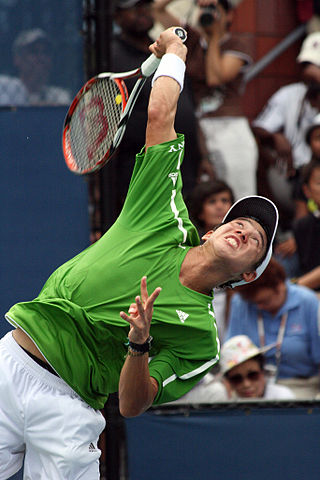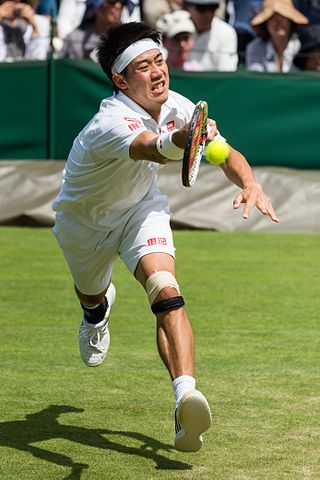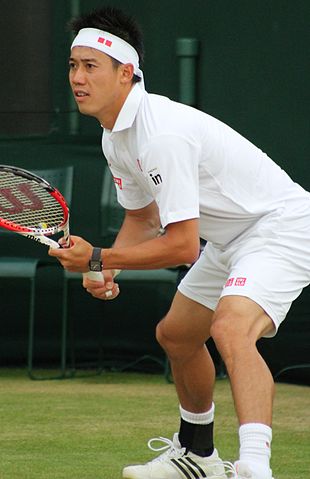
In 2022, I’m counting down the 128 best players of the last century. With luck, we’ll get to #1 in December. Enjoy!
* * *
Kei Nishikori [JPN]Born: 29 December 1989
Career: 2007-present (15+ seasons)
Plays: Right-handed (two-handed backhand)
Peak ATP rank: 4 (2 March 2015)
Peak Elo rating: 2,210 (3rd place, 2016)
Major singles titles: 0 (2014 US Open finalist)
Total ATP singles titles: 12
* * *
No majors, no Masters titles, no semi-finals at three of the four slams, and a mere nine weeks in the top four the ATP rankings. What on earth is Kei Nishikori doing on this list?
Nishikori’s entire career has overlapped with the reign of the Big Four. He never made much progress against them in head-to-heads, going 2-18 against Novak Djokovic, 2-12 versus Rafael Nadal, 2-9 against Andy Murray, and 3-8 facing Roger Federer. My Elo ratings and the official ATP rankings agree that Kei only broke the quartet’s stranglehold on the top four spots when Roger or Rafa was injured, except for a brief spell when Elo had him in a dead heat with Murray.
You could be an extremely good player in the mid-2010s and never sniff the #3 ranking. You could be a very good player for an entire decade and never win a big title. The generations of men born between about 1985 and 1995 weren’t bad, they just had unfortunate timing. So Kei and a handful of other all-time greats are stuck with distinctly mediocre-looking records.
For four or five years in the middle of the last decade, Nishikori was the fifth best player on tour. He didn’t have the capacity to redline his game for the two weeks of a major, like Stan Wawrinka did. He didn’t have the raw power to blast the top guys off the court, as did Juan Martin del Potro. But his quickness, court sense, and shotmaking abilities made him a factor every time he showed up healthy for a tournament.
* * *
Nishikori never cracked the top three on the ATP computer, but his climb up the rankings had more than its share of drama. His nation was watching, and when he cracked the top 45, he set the first of many new records for Japanese men. Kei’s path-breaking progress made him enormously popular at home, even if he never dislodged the Big Four.
Beyond his status as a Japanese hero, what sets Nishikori apart–even though it hasn’t translated into many titles–is his uncanny ability to win deciding sets.
I first wrote about Kei’s deciding-set domination in April of 2015. At the time, he had won 27 of his last 30 deciding sets, a nearly unbeatable run that stretched over more than a year. It wasn’t even that unusual for him. He had reeled off 17 consecutive deciding sets in 2011-12, part of another 27-for-30 streak. No one else had ever won more than 27 in 30, and only nine other players–including Djokovic, Federer, Nadal, and Michael Chang–had achieved the same feat.
His career record in deciding sets, as of April 29, 2015, was 75-20, a 79% winning percentage. No one else in the Open Era came close. Bjorn Borg was second, at 75%, followed by Djokovic. Novak’s mark at the time was 74%, and has since dropped to 73%. No other played topped 70%.

Credit: Andrew Klein
Injuries and regression to the mean have brought Nishikori back to earth a bit, but almost seven years later, his record in deciding sets still stands at 72% (149-57), behind only Borg and Djokovic. Sure, some of the 200-plus deciders were against middling players he should’ve beaten in straights. (Even Borg and Djokovic have a few of those.) But that doesn’t fully account for his historically great record. He is 42-28 in deciding sets against the top 20 (42-23 through 2018), 25-17 versus the top ten (25-13 through 2020), and 13-11 against the top five.
Nishikori isn’t one of the top 100 players of all time. But if greatness were measured by the amount a player improved heading into the third or fifth set, he’d be top ten.
* * *
There’s no doubt that Kei gets better in one-set shootouts. There are 120 players who have won at least 50 best-of-three matches in deciding sets since 2000. Of that group, Nishikori holds the second-best record in third sets. Only Djokovic is better.
Another way to measure a player’s improvement in the final set is to compare their deciding-set win rate with their overall percentage of sets won. Good players win the majority of their matches, most of them in straights, so the opponents who push them to third sets are, almost by definition, better than average. As a consequence, most players win a lower rate of deciding sets than overall sets. Stan Wawrinka is a good example. In best-of-threes, he has taken 63% of total sets. He wins only 58% of third sets. More than three-quarters of 21st-century players fit the same mold, losing more deciding sets than total sets.
Not Nishikori. His third-set win percentage is not only better than his win rate in first and second sets, it exceeds his own rate of winning earlier sets by a wider margin than anyone else’s. He has won 65% of total sets and 71% of deciders. The resulting difference of six percentage points is better than that of any other player in the era, and it’s not even close. Only one other active player–David Goffin–has managed even a three-percentage-point difference.
One part of the explanation is that Kei is as streaky as anyone on tour. That isn’t the whole story, because the mere fact that a player is streaky doesn’t mean he’s going to have good streaks at the right moments, as Nishikori so often has. Still, very few players endure three-set roller-coasters quite like he does.

Credit: David Iliff
When Nishikori goes the distance in a best-of-three, the first two sets tend to be lopsided. On average, he wins 3.5 games in the sets he loses, and he gives away 3.5 games in the first set he wins. Those numbers may not sound noteworthy, but with the small margins that prove decisive in men’s tennis, they are considerably more extreme than average. Compared to the 120 players with extensive deciding-set records in this century, only 13 players win fewer games in the sets they drop. (You won’t be surprised to learn that Fabio Fognini leads this category, with 3.1.) Only 17 players lose fewer games in the first sets they win. (Another non-surprise: Djokovic tops this list, with 3.2.)
A ranking of 13th or 17th among 120 players is hardly jaw-dropping stuff. But only three players are more extreme in both categories than Nishikori, and two of them are clay-courters, Alberto Martin and Guillermo Coria. The third is Stefan Koubek. No active ATPer plays more lopsided 1st and 2nd sets in the matches that end up going three.
* * *
The players among Kei’s contemporaries who win a lot of deciding sets do so because they are flat-out good at tennis. Djokovic is slightly better than Nishikori in best-of-threes that go the distance, but there’s no magic to it. He wins 78% of all sets, while Kei manages only 65%. Novak is worse in deciders than other sets (again, because of the higher level of competition), while Kei somehow gets better.
Nishikori’s deciding-set record, jaw-dropping as it is, manages to understate just how much he improves when the deciding set arrives. The transition from 2nd to 3rd set (or 4th to 5th) somehow converts him from a mediocre player that couldn’t get the job done in straights to a stronger server, a better returner, and an absolute beast when faced with break point.
I looked at point-by-point data for 108 of Kei’s deciding-set matches to get a sense of how he changes. It’s a sizable and more or less random sample of his deciders between 2011 to 2018. You can find most of the raw data in one of my GitHub repos.
Nishikori won 63.0% of service points in the first and second sets (or first four sets, in best-of-fives) of these matches. That’s considerably worse than his 64.4% average from 2011 to 2018. His opponents in these matches were better than the ones he dismissed in straight sets, which may explain the entire difference. In the deciding sets of these matches, his winning percentage on serve increased to 66.4%. A jump of three percentage points is huge–it takes him from a below-average server to an above-average one. In 2021 terms, he improved from the equivalent of Marton Fucsovics to the equal of Denis Shapovalov.
Kei upped his game on the other side of the ball in final sets, as well. Before the decider, he won 37.8% of return points. In the final set: 40.7%. The first number is roughly tour average, while anything above 40% is elite. With the match on the line, he started treating above-average-serving opponents like weak ones.

Credit: si.robi
If Nishikori had figured out how to win two-thirds of his serve points and 41% of his return points any time he faced a strong player, we’d have spent the last decade talking about a Big Five. (And not the one with Wawrinka in it.) Those two numbers are close to Andy Murray’s level over his entire career. Such a dramatic improvement in deciding sets explains why Kei dominated when the finish line was in sight.
But it still isn’t the whole story. When a match comes down to a single set, one run of bad luck can turn into a break of serve, and one break can determine the outcome. Nishikori became remarkably good at preventing that from happening.
In the first two (or four) sets of these matches, Kei saved only 59% break points against him. That’s well below his career average, and it’s not very good by any standard. Only a handful of players in today’s ATP top 50 save fewer break points. But in deciders, Nishikori shut down 68% of break points. Like his deciding-set return game, that’s elite stuff. Novak Djokovic won three majors in 2021 while saving only 67% of break points. A nine-percentage-point swing in a stat like this means that Kei’s opponents suddenly found themselves up against an entirely different player.
* * *
Nishikori’s story has always been full of what-ifs. What if his career didn’t overlap with the Big Four era? What if he had stayed healthy? (His Wikipedia page uses some variation of the word “injury” 30 times, and in the few weeks since I wrote the first draft of this essay, he went under the knife again.) What if Marin Cilic hadn’t brought his best game to the 2014 US Open final?
We can add another mouth-watering hypothetical to the list. What if Nishikori had been able to sustain his level of deciding-set focus and execution for entire matches? We got glimpses of that potential when he upset Djokovic to reach the 2014 US Open final and when he battled Nadal for nearly three hours in the 2016 Olympics bronze medal match.
Maybe there are still reasons to be optimistic. Kei is still only 32 years old, younger than Djokovic and Nadal and considerably more experienced than the rest of the top ten. He beat Andrey Rublev at the Olympics last summer, and he took sets from Rafa, Alexander Zverev, and Stefanos Tsitsipas in the last 12 months. He’ll miss most of the 2022 season recovering from hip surgery, so the rosy view is that he’ll come back rested and even stronger.
At least some of the old magic is still there: He won 14 deciding sets last year in only 22 tries. You never know–maybe Nishikori has another year-end #5 in him.